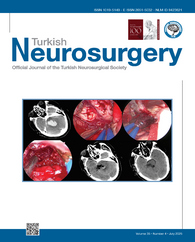2Etlik City Hospital, Department of Neurosurgery, Ankara, Türkiye
3Zonguldak Bulent Ecevit University, Department of Neurosurgery, Zonguldak, Türkiye
4Kanuni Training and Research Hospital, Department of Neurosurgery, Trabzon, Türkiye
5Ado Group, Process Management Coordinator, Antalya, Türkiye
6A Life Health Group Hospital, Department of Neurosurgery, Ankara, Türkiye
7Balikesir Atatürk State Hospital, Department of Neurosurgery, Balikesir, Türkiye
8VM Medical Park Mersin Hospital, Department of Neurosurgery, Mersin, Türkiye
9Pamukkale University, School of Medicine, Department of Neurology, Denizli, Türkiye
10TOBB ETU School of Medicine Hospital, Department of Neurosurgery, Ankara, Türkiye DOI : 10.5137/1019-5149.JTN.48420-25.2 AIM: To evaluate the clinical and radiological outcomes of newly established Turkish neurosurgical stroke centers , and to assess their competency in managing acute ischemic stroke from June 2023 to June 2024.
MATERIAL and METHODS: We retrospectively analyzed data from 69 patients (mean age = 69.06 ± 13.48 years) from three stroke centers in Türkiye by reviewing hospital records and patient interviews, focusing on demographic variables, comorbidities, treatment methodologies, outcomes (using the Modified Rankin Scale (mRS)), stroke severity (using the National Institutes of Health Stroke Scale [NIHSS]), Alberta Stroke Program Early CT (ASPECT) scores, reperfusion status (using the modified Thrombolysis in Cerebral Ischemia (mTICI) score), complications, blood glucose levels, and creatinine levels.
RESULTS: Of 392 acute ischemic stroke patients, 280 (71.4%) had no identifiable occlusion, 43 (11%) were out of the MT time window, and 69 (17.6%) underwent MT, with 57 (14.5%) having LVO and 12 (3%) MVO. Final reperfusion (mTICI ?2b) was achieved in 78.3% of MT patients, and 29% achieved favorable outcomes (mRS ?2) at three months. Younger age, lower baseline NIHSS, and higher ASPECT scores correlated with better outcomes, while elevated blood glucose (>127.50 mg/dL) and creatinine (>0.80 mg/dL) were linked to worse mRS scores. Complications occurred in 21.7%, including symptomatic intracranial hemorrhage in six patients.
CONCLUSION: While Turkish neurosurgical stroke centers have made significant strides in managing acute ischemic stroke, challenges remain in optimizing patient outcomes. This initial experience underscores the need for further research, continued training, and educational standardization for neurosurgeons in endovascular techniques to improve patient care.
Keywords : Acute ischemic stroke, Mechanical thrombectomy, Stroke center, Neurosurgeon




